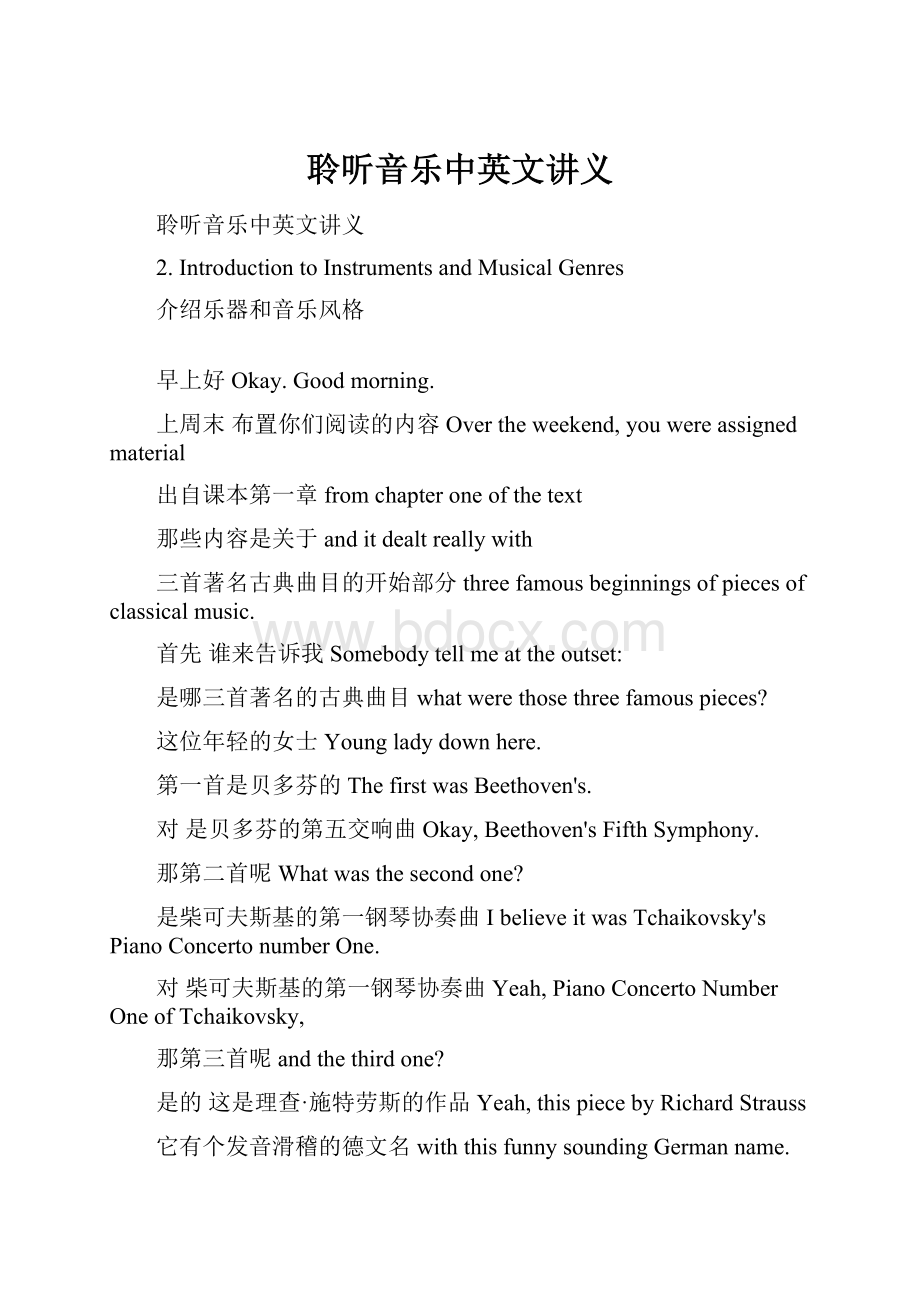聆听音乐中英文讲义.docx
《聆听音乐中英文讲义.docx》由会员分享,可在线阅读,更多相关《聆听音乐中英文讲义.docx(42页珍藏版)》请在冰豆网上搜索。

聆听音乐中英文讲义
聆听音乐中英文讲义
2.IntroductiontoInstrumentsandMusicalGenres
介绍乐器和音乐风格
早上好Okay.Goodmorning.
上周末布置你们阅读的内容Overtheweekend,youwereassignedmaterial
出自课本第一章fromchapteroneofthetext
那些内容是关于anditdealtreallywith
三首著名古典曲目的开始部分threefamousbeginningsofpiecesofclassicalmusic.
首先谁来告诉我Somebodytellmeattheoutset:
是哪三首著名的古典曲目whatwerethosethreefamouspieces?
这位年轻的女士Youngladydownhere.
第一首是贝多芬的ThefirstwasBeethoven's.
对是贝多芬的第五交响曲Okay,Beethoven'sFifthSymphony.
那第二首呢Whatwasthesecondone?
是柴可夫斯基的第一钢琴协奏曲IbelieveitwasTchaikovsky'sPianoConcertonumberOne.
对柴可夫斯基的第一钢琴协奏曲Yeah,PianoConcertoNumberOneofTchaikovsky,
那第三首呢andthethirdone?
是的这是理查·施特劳斯的作品Yeah,thispiecebyRichardStrauss
它有个发音滑稽的德文名withthisfunnysoundingGermanname.
我们称之为查拉图斯特拉就好了We'lljustcallitZarathustra,
查拉图斯特拉是位先知thisprophet,Zarathustra.
就是这三首乐曲Sothosearethethreepieces
与它们的音乐风格相关的知识andtheissuestherehadtodowithmusicalgenre
我们接下来会进一步探讨thatwe'regoingtotalkalittlebitmoreaboutinamoment,
还有关于乐器的知识andtheinstruments.
你们先前做过Andyouwentaheadandworkedwiththe
听力练习九至十一题ListeningExercisesninethrougheleven
在这些练习中toengagethemusicalinstrumentsabit
你们增长了对乐器的一些认识inthoseparticularexercises,
今天我们请来了表演者andwehaveperformersheretoday
你们将看到他们稍候thataregoingto,asyoucansee,
将为我们在这里演示一些乐器demonstratesomeoftheseinstrumentsforus.
首先我们得明确一点Let'smakeonepointveryclearattheoutset.
我经常见到学生撰写的论文中提到OftentimesIgetstudentpapersthatreferto
贝多芬的第五交响曲"Beethoven'sfifthsong"
或是柴可夫斯基的第一钢琴协奏曲Or"Tchaikovsky'sfirstpianosong."
这样好吗Isthatright?
不一点不好No,that'snotgoodatall.
那些是歌曲吗Arethesesongs?
一首歌里哪些因素不可或缺呢Whatdoyouhavetohavetomakesomethingasong?
是歌词Lyrics.
你得有文字You'vegottohaveatext
而百分之八十的古典乐中却没有andsowedon'thave--ineightypercentofclassicalmusic--
没有歌词wedon'thavelyrics;
没有文字wedon'thaveatext.
没错歌剧中是有歌词的Well,yes,withoperaofcourse,
但其他百分之八十的古典乐都是纯器乐buttheothereightypercentispurelyinstrumentalmusic.
纯器乐的演奏方式容我重申Itworksitsmagic,again,
能产生神奇的效果throughpurelyinstrumentalmeans,
所以我们其实不能把器乐称为歌曲sowecan'treallycallthosesongs,
这让我很困惑andthispuzzledme.
有天我在苹果的iTunes音乐商店OnedayIwassittingthereatiTunes
想买首莫扎特小夜曲它属于室内乐andIwantedtobuyaninteriormovementofaMozartserenade
我准备买下时网页上显示soIwasallsettopurchasethisanditsaid,
"购买歌曲""Buysong."Boom.
我灵机一动想到了问题关键Thattoldmetheanswer.
这就是这个术语的由来That'swherethisterminologycomesintoplay
我们在iTunes音乐商店购买歌曲becauseoniTuneswebuysongs.
可能买的是纯器乐Itcouldbepurelyinstrumental
却被称为"买首歌"butit'scalled"Buyasong,"
但我们不想用那种说法Butwedon'twanttousethatsortofparlance.
我们想用些更精确的词藻Wewanttobemore--abitmoresophisticatedthanthat,
用其他措辞表现ifyouwill,anduseotherterms,
我们一般会说贝多芬的音乐创作sowe'lltalkgenerallyaboutBeethoven'scomposition
或贝多芬的乐章贝多芬的乐曲orBeethoven'spieceorBeethoven'swork
他的杰作或名曲orhismasterworkorchefd'oeuvre
或是任何你想到的花哨词汇称呼它orhoweverfancyyouwanttogetwithit.
我们还可以进一步Wecouldalsogoon
更加精确地说andbealittlemorepreciseandsay
它属于某种独特的音乐风格itbelongstoaparticulargenre.
我们可以用某种音乐风格描述它Wecouldusethenameofagenre,
本课程中我将会谈到很多音乐风格andI'llbetalkingalotaboutgenreinthiscourse.
风格只是某种比种类或类别"Genre"Issimplyafancyword
更花哨的说法for"Type"Or"Kind"
那这首贝多芬作品属于什么风格呢sowhatgenreofpieceisthisbyBeethoven?
是交响乐Well,it'sasymphony.
交响乐一般有四个乐章Symphoniesgenerallyhavefourmovements.
那什么是乐章呢What'samovement?
简单来说乐章就是些各自独立的篇章Well,amovementissimplyanindependentpiece,
在一首交响曲或协奏曲内thatworksoftentimes--iftherearremultiplemovementsinasymphonyorconcerto--
和其他的乐章和谐统一workswithothermovements.
它们彼此独立但又彼此互补Theyareindependentyettheyarecomplementary.
打个比方想象一下有个雕塑花园Thinkof,forexample,asculpturegarden.
你有四个独立的雕塑Youmighthavefourindependentsculpturesinthere,
但他们却彼此联系buttheyrelateonetoanother;
彼此间好像有某种特别的意义theymakesomesortofspecialsenseonetoanother.
交响曲有四个乐章Sosymphonieshavethesefourmovements
而且通常用以下的方式演奏andtheyusuallyoperateinthefollowingway:
一个简短的开始部分的乐章Afastopeningmovement;
一个缓慢的更为抒情的第二乐章aslower,morelyricalsecondmovement;
接着是个衍生自舞曲的第三乐章thenathirdmovementthat'sderivedfromdance;
加上第四乐章andthenafourthmovement
再次出现"快节奏"迅速而强势的总结that'ssortofagain"Uptempo".Fast,emphaticconclusion.
让我们通过迅速回顾贝多芬的第五交响曲Let'sseehowtheseplayoutbymeansofaquickreviewof
看乐章是如何表现的Beethoven'sFifthSymphony
我们现在要从soallwe'regoingtodohere
乐曲的第一乐章开头开始isgoingtogofromthebeginningofthetrackforthefirstmovement
听到第二乐章以此类推tothesecondmovementandsoon,
好让我们从这开始andwell,let'sjuststarthere.
让我们唤醒自己的记忆Let'sjust,bywayofrefreshingourmemory,
温习贝多芬第五交响曲的开始乐段thebeginningofBeethoven'sFifthSymphony.
稍微停一下就像我们上次所说的那样Let'spauseitthere,andaswesaidlasttime,
它是这样itoperates
编排的inthatfashion,
乐曲的开始乐段给了我们很好的范例andthatbeginninggivesusagoodopportunity
来区分两种旋律类型tomakeadistinctionbetweentwotypesofmelody,
区分动机和主题betweenthisideaofamotiveandatheme.
两种都属于旋律的范畴Botharesortofsubsetsofmelody,ifyouwill.
正如我在课本里所说的AsIsayinthetextbookthere,
听到贝多芬的第五交响曲开始乐段thebeginningoftheBeethovenFifth
就像有人用音乐在你鼻子上猛击了一拳issomethinglikeamusicalpunchinthenose.
对不对Right?
就像一把将你抓住Sortofgrabbingyouhere,
用音乐不停击打你的脸hittingyouintheface,whatever,musically.
这段旋律并不长It'snotaverylongidea.
开始的这部分有几个音符Howmanynotesisinthisopeninggambithere?
几种音高Howmanypitches?
四个Four,
短音短音短音长音short,short,short,long.
好这是个动机的典型示例Okay.Sothat'saclassicexampleofamotive.
动机只是个微小的细胞一个胚芽Amotiveisjustalittlecell,agerm,
基于它作曲家会创造新的音乐素材outofwhichthecomposerwillbuildothermusicalmaterial.
现在我们拿它来对比下Nowlet'scontrastthatwithwhathappens
贝多芬第五交响曲的第二乐章inthesecondmovementofBeethoven'sFifthSymphony
这部分有长时间抒情的流畅主题开始wherewehavealyrical,long,flowingtheme.Okay?
好暂停Okay.We'llstopthere.Allright?
我们继续探讨如果听完这部分Sothatwenton--Ifweheardthewholething,
这个主题接下来还有三十二个音符itactuallygoesonfornotes
与区区四个音符的动机相对asopposedtojustfour
动机与篇幅更长的主题相对somotiveversuslongertheme.
主题可能更趋于抒情Themestendmaybealittlebitmorelyrical.
现在接着谈第三乐章Nowlet'sgoontothethirdmovement.
我们说过第三乐章是由舞曲衍生的Wesaidthethirdmovementwasdancederived,
但贝多芬这第三乐章里这舞曲很怪异butinthiscasewithBeethovenit'saverystrangedance
如果它的确是由舞曲衍生的话ifitisdancederived.
和大部分其他第三乐章相比It'sjustalittlebitdifferent
它有些许的不同thanmostofthesethirdmovements,
无论如何我们先来听听butlet'slistentoitanyway
因为我希望你们在铜管奏响时becauseI'dlikeyouto--whenthebrassescomein--
思考你们听到了什么thinkaboutwhatyou'rehearing
思考它和第一乐章的关系\Nandthinkaboutthatvis-à-visthefirstmovement,
现在听第三乐章solet'shearthethirdmovementnow.
铜管奏响时发生了什么Okay.Sowhathappenedtherewhenthebrassescamein?
它是怎样和第一乐章联系起来的Howdidthatrelatetothefirstmovement?
-你吗-四个音符-Yes?
-Fournotes?
四个音符就这么简单Fournotes,somethingassimpleasthat,
同样的节奏所以这就是动机的运用samerhythmicidea,sothat'stheuseofamotivethere
这就是乐章间的微妙联系所在andthat'showthesemovementsaretiedtogetheralittlebit.
现在要接近终曲了Let'sgoontothefinalenow,
当我们听最后乐章时andaswelistentothefinale
让我们想想在乐曲开头听到了什么let'sthinkaboutwhatweheardattheverybeginning
还有上次我们谈到的内容andtalkedaboutlasttime,
关于第五交响曲开头的感情基调aboutthemoodthatthebeginningoftheFifthSymphonycreatedforit.
我们会用些形容词Wehavetheseadjectivesuphere,
像是消极的焦虑的怀疑的"Negative,""Anxious,""Unsettled."
我们对最终乐章感觉如何这感觉从何而来Well,howdowefeelnowaboutthefinaleandwhy?
音量关小一点就好我们继续讲Youjustturnthevolumedownalittlebitsowe'llgoon.
为什么我们会感觉不一样Sowhydowefeeldifferentlyaboutthat?
我想确实不同Ithinkwedo.
在这里我们体会到什么Whatdowefeelthere?
一种乐观积极Well,sortofupbeat,positive.
是什么使感情基调逆转具体是什么What'sturnedallofthisaround,whatspecifically?
在第一乐章我们说过它大体上Well,withthefirstmovementwesaidhe'sgenerallygoing
就像这样但现在andthatkindofidea,butnowit's
我们讲到和弦时再来研究这个andwe'llexplorethiswhenwegettoharmony,
大调和小调的概念我们继续听音乐thisideaofmajorandminorsowe'regoingmusic
还有这个andnow
这就是小调到大调间的转变andthat'sachangefromthedarkminor
由阴郁转向明亮tothebrightermajor.
第一乐章中我们曾情绪低落但现在Weweregoingdowninthefirstmovement.Nowwe'regoing--
情绪正高涨It'sgoingup
刚才小提琴演奏的部分andinsteadofhavingjusttheviolinsplaying
换成了小号豪情万丈的小号wehavethetrumpets,theheroictrumpets,
听上去有种胜利的喜悦soitsoundsverytriumphant.
在这四十分钟的乐曲里Sointhis-minuteinterval
我们走完了一趟情感丰富的音乐旅程we'vegonesortofthroughanemotionalmusicaljourneyherefromdespair,
从消沉沮丧到半信半疑再到个人胜利despondency,uncertainty,towhatever-topersonaltriumph,
其实在某种意义上也反映了事实andinawaythatmirrorssomeofthethings
贝多芬的人生也将经历相似的历程thatweregoingoninBeethoven'slife.
好吧Okay.
让我们接着讲第二首乐曲Let'sgoontotalkaboutthesecondpiece.
我们讲完这种风格和它的四个乐章Wefinishedwiththisideaofthegenre,ofthefourmovements,
下面要探讨的是钢琴协奏曲sothenlet'sgoontotalkaboutthepianoconcerto.
协奏曲一般有三个乐章Concertosaregenerallyinthreemovements.
协奏曲是另外一种风格Theconcertoisanothergenre.
这种风格中独奏乐器要和管弦乐队分庭抗礼It'sagenreinwhichasoloistwillconfronttheorchestra
就会出现一种协作与让步andthere'llbeakindofgiveandtake
两者间会存在协作与让步的精神aspiritedgiveandtake--betweenthetwo.
现在我们要听到的是Sonowwearegoingtolistento
柴可夫斯基第一钢琴协奏曲的开始乐段thebeginningofthefirstmovementofTchaikovsky'sPianoConcerto.
我们听过这首曲子You'veworkedwiththisalready
你们会觉得有些熟悉soyou'realittlebitfamiliarwithit,
开始前我为你们准备了两个问题andattheoutsethereIhavetwoquestionsforyou.
这里的开始乐段是由哪种乐器演奏的Isthebeginninghereplayed
铜管乐器还是弦乐器bythebrassesorthestrings?
或者是木管乐器换句话说Inotherwords,what--orthewoodwinds--
这里演奏的是什么乐器whatfamilyofinstrumentsisplayinghere
还有柴可夫